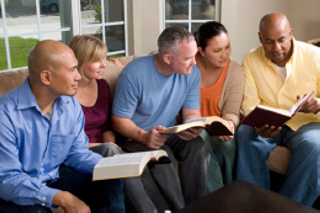Our modern society is accustomed to believers of any faith gathering in unique buildings. Churches, Synagogues and other buildings constructed for the express purpose of worship exist throughout the world. For early Christians, however, such dedicated structures servicing believers simply did not exist. Fellowships based in a home were, in many cases, the ONLY way believers could come together as a group.
At least twenty-one home fellowships are found scattered throughout the New Testament. After the death of Jesus, the early church met mostly in small groups where someone lived. These gatherings show us it is perfectly acceptable to meet in this fashion for the express purpose of learning what the Bible teaches and for worshipping God.
There is direct evidence that many early believers gathered in a home to worship God and encourage each other. When Paul wrote his first epistle to the Corinthians in 56 A.D. he mentioned a group of believers coming together each Sabbath at the place where fellow laborers Priscilla and Aquila lived (1Corinthians 16:19). His greeting to Philemon makes it clear that there were Christians meeting in his home (Philemon 1 - 2).

In the area around Laodicea there appears to be have been two groups of Christians meeting in a home. Paul's epistle to believers in Colossae makes a direct reference to a church meeting at someone's residence (Colossians 4:15). He then mentions "the church of the Laodiceans" (verse 16), which might have been another of several groups meeting in the area.
Members in the Jerusalem church seem to have initially used their homes for food and to commune with one another (Acts 2:46). Later, church leaders would visit where people lived, near the Temple, to help spread the gospel and encourage Christians in the way of God (Acts 5:42).
Before his conversion, Saul (before he became Paul) persecuted believers. Luke tells us that Saul was so zealous that he would enter a person's home looking for those to arrest and throw in jail (Acts 8:3). Why did he do this? He did this because such dwellings were places where fellowships met and where he was likely to find several people he could send to prison.
When another wave of persecution hit more than ten years later people were still meeting in someone's home for services. We know this because Acts tells us that one of them in Jerusalem got together, when Peter was arrested, to pray for him (Acts 12:1 - 5).
Paul, toward the end of his third missionary journey, meets in Miletus with elders from the Ephesus church (Acts 20:17). Reminding them of his integrity as a preacher, he states he never withheld anything helpful when he taught in their fellowships which were conducted in a person's home (verse 20). The apostle preached in these places because that is where Christians met.
Many false teachers and prophets, by the time Paul wrote his letter to Titus in 63 A.D., had begun visiting fellowships held in a home as a way to spread their deceitful doctrines.
Paul warns Titus, "For there are many . . . who rebel and deceive others with their nonsense. It is necessary to stop their talk, because they are upsetting whole families ('houses' in the Greek) . . ." (Titus 1:10 - 11). Timothy also received a similar warning from him (2Timothy 3:5 - 6).
In spite of its risks, home fellowships for the purpose of worshipping God and studying the Bible was an acceptable practice in the first century. It is still acceptable today.